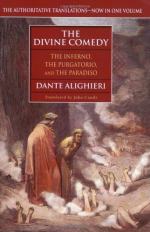|
This section contains 3,829 words (approx. 13 pages at 300 words per page) |

|
Movement and Stasis in the Divine Comedy
Movement is a crucial theme of the Divine Comedy. From the outset, we are confronted with the physicality of the lost Dante, wandering in the perilous dark wood. His movement within the strange place is confused and faltering; `Io non so ben ridir com'io v'entrai'. Moreover, it is clear that the physical distress he is experiencing is the visible manifestation of the mental anguish the poet is suffering. The allegory of the image is one of mid-life crisis, but it is physically represented by the man losing his way in a dark wood. Such an observation may seem far too simple and obvious to be worthy of comment. However, I would argue that it is from this primary example of the deep connection between the physical and the mental, that one can begin to categorise and explain...
|
This section contains 3,829 words (approx. 13 pages at 300 words per page) |

|


